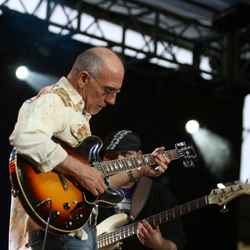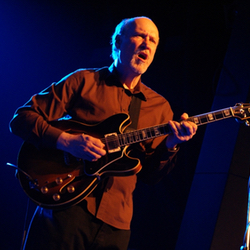Jazz Guitar
The role of jazz guitar within the world of jazz itself has evolved considerably since the early days of this distinctly American music. In fact, the evolution of the usage of the guitar in jazz follows the evolution of the guitar itself (specifically the electric guitar).
A Viable Solo Instrument
Originally a part of the rhythm section and rarely a solo instrument,
players like Charlie Christian and Wes Montgomery showed that the guitar
could also be a viable and powerful solo instrument, though rhythm
specialists like Freddie Green set a high standard for the role of
guitar as an accompaniment instrument. The rise of the guitar as a solo instrument can be attributed in part to developments in amplifying the instrument. Indeed, the "Charlie Christian pickup" was a major innovation in the history of the guitar itself.
A Complex Instrument
Perhaps more so than another other genre, jazz requires its
adherents to have a solid grasp of both practical and applied theory.
Jazz is easily the most rhythmically, harmonically and melodically
complex music around. While "learning" the guitar can be relatively easy
in more popular forms of music, jazz (if played well) requires a much
higher level of musicianship that is typically found in other genres,
though there it isn't difficult to find rock players with astute jazz
sensibilities and vice versa. It takes players years to master the
elements necessary to play jazz at a high level.
The Rise of Fusion
One of the most
popular forms of jazz in the contemporary music world is fusion, which
refers to the marriage of jazz and rock styles. For example, a typical
fusion tune may involve more sparse harmonic changes so a soloist can
explore different modal variations. In other words, rock chords, jazz soloing (though it's not quite that simple). For a guitarist, he or she may
approach the instrument not unlike a heavy rock player regarding their
tone, though the lines played are generally more complex than typical
rock licks. Popular fusion players include Allan Holdsworth, Frank
Gambale, Larry Carlton, and Scott Henderson.
Jazz Guitar Gear
Traditionally, jazz players used large hollow body guitars like a Gibson ES-175 (generally with flatwound strings) through super clean amplifiers such as a Roland JC-120 or Polytone Brute. However, many players such as Joe Pass, Ed Bickert, and Ted Greene used solidbody instruments like the Fender Telecaster with great success.
Today, there are no strict rules about the type of guitar or amplifier one uses, though most players will favor a warm-voiced neck pickup through a clean amplifier when playing traditional jazz. For fusion players, however, there are more options, including a wide array of effects devices as well as more rock-flavored amplification.
We offer several resources on jazz, including free lessons, equipment counseling, essential listening, and book recommendations. Enjoy your stay!
Add Your Comments Here!
I'd love for you to be a contributor to SoMuchGuitar.com!
Just fill out the information below to add to this page. I'll be in touch about your submission soon!

